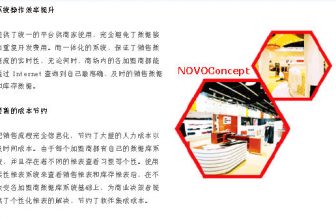
Santa Fe Optical Store RFID Application Case
[ad_1]
In recent years, the American Santa Fe Optical Store has deployed an RFID security system in its store in Austin, Texas. Before the installation of the system, the store lost as much as $12,000 per year due to theft. After the application of the system, the store reduced the loss to zero. Currently, Santa Fe is adding an RFID-based inventory management system to its existing system.
The system used by the Santa Fe Optical Store includes a 915 MHz EPC Gen 2 RFID tag purchased from Avery Dennison’s Printer Systems Division. The label is designed by Avery Dennison in the shape of an hourglass and can be attached to the temples of the glasses through adhesive. The hardware and integration services of the system, including handheld RFID readers and antennas, are provided by Electronic Inventory Solutions (EIS). EIS was established in 2003 and is located in Carrollton, Texas. It specializes in providing RFID system solutions for high-value markets. Its business includes designing and manufacturing RFID hardware, software and system integration services for retailers. EIS products mainly include RFID security systems and handheld verification systems, all of which can be used to improve the visibility of customer assets.
When the Santa Fe Optical Store opened its third store in Austin a year ago, there were frequent thefts in the store, and the loss caused by each theft was as high as $5,000. To this end, Bob Ross, an optometrist at the shop, began to look for a security system and required that the system label should not be as big as the label used in the electronic article surveillance system (EAS). Because if a label as big as an EAS label is used (RF bulletin: EAS label size is 1.5×2 inches long; 1 inch wide; 1/8 inch thick), customers will have a lot of difficulties when trying out the frame. Darryl Hubbard, president of EIS, pointed out that one of the attractions of RFID tags is their small size. Almost a year ago, Rose found and cooperated with EIS and installed a set of RFID-based access control system, in which the antenna device was connected to the alarm. After installing this system, employees will first put RFID tags on the temples before entering the warehouse. These labels are as thin as paper before being pasted, and their dimensions are 1.75 x 1.25 inches. When attached to the temple of the glasses, the label will be folded in half again. Each label is printed with a code, which is the same as the code on the RFID chip in the label. At the same time, employees manually input RFID tag codes and other information such as frame manufacturer, receipt date, and price into the stock database of the optical shop.
When selling a pair of glasses, the employee will tear off the RFID tag on the temple. If the label is moved without being torn off, and the customer tries to pass through the door and the store entrance, an alarm will be triggered. Hubbard said that RFID tags have been proven to be very reliable, and every tag provided by Avery Dennison® can operate normally. This security system has been tested very successfully, and Santa Fe has decided to extend the RFID system to the entire inventory process. In the past, the inventory process was usually manual and recorded with pen and paper. EIS is currently installing an RFID system in this process, and employees can use handheld RFID readers to automatically count the entire store. This closed-loop RFID system is currently being integrated into the Santa Fe glasses store’s inventory database. According to Hubbard, the inventory management system will be launched in two months.
The working manager of the system is as follows: In the optical shop, the designer or manufacturer will display the glasses in cabinets. Once the inventory management system is in place, employees can download the inventory serial number associated with a specific counter to the handheld reader, and then use the handheld reader to walk around the counter. At this time, a list of glasses inventory numbers will appear on the small screen of the reader. After the reader reads the RFID tags on the glasses frame, these numbers will disappear from the screen. If there are any numbers on the screen, employees can walk to other counters in the store to find the corresponding frame.
Hubbard said that the use of RFID systems will help Santa Fe optical shops reduce inventory count time by 80%. Using handheld readers, employees only need 40 minutes to complete the inventory count, and if not using RFID technology, it would take at least eight hours. Once the optical shop officially implements the inventory system, Santa Fe will deploy two systems in the other two stores, including an RFID security system and an RFID inventory management system.
When selling a pair of glasses, the employee will tear off the RFID tag on the temple. If the label is moved without being torn off, and the customer tries to pass through the door and the store entrance, an alarm will be triggered. Hubbard said that RFID tags have been proven to be very reliable, and every tag provided by Avery Dennison® can operate normally. This security system has been tested very successfully, and Santa Fe has decided to extend the RFID system to the entire inventory process. In the past, the inventory process was usually manual and recorded with pen and paper. EIS is currently installing an RFID system in this process, and employees can use handheld RFID readers to automatically count the entire store. This closed-loop RFID system is currently being integrated into the Santa Fe glasses store’s inventory database. According to Hubbard, the inventory management system will be launched in two months.
The working manager of the system is as follows: In the optical shop, the designer or manufacturer will display the glasses in cabinets. Once the inventory management system is in place, employees can download the inventory serial number associated with a specific counter to the handheld reader, and then use the handheld reader to walk around the counter. At this time, a list of glasses inventory numbers will appear on the small screen of the reader. After the reader reads the RFID tags on the glasses frame, these numbers will disappear from the screen. If there are any numbers on the screen, employees can walk to other counters in the store to find the corresponding frame.
Hubbard said that the use of RFID systems will help Santa Fe optical shops reduce inventory count time by 80%. Using handheld readers, employees only need 40 minutes to complete the inventory count, and if not using RFID technology, it would take at least eight hours. Once the optical shop officially implements the inventory system, Santa Fe will deploy two systems in the other two stores, including an RFID security system and an RFID inventory management system.
[ad_2]






